|
NEWSLETTER / NOVEMBER 2024
Salt Season
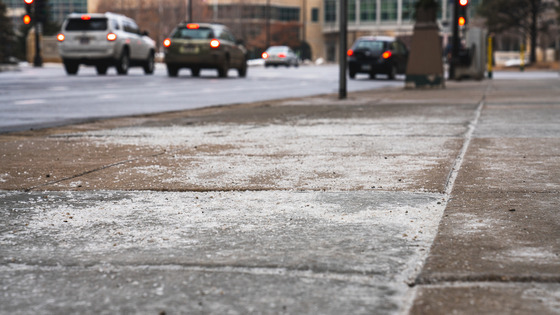 Salt season (aka “winter”) is nearly upon us and many Minnesotans are gearing up for snow and ice management, but it's important to keep in mind the environmental toll of road salts and deicers. Chloride, the main component of road salt, is a major pollutant in Minnesota’s waterbodies. Once chloride enters our lakes, rivers, and groundwater, it’s impossible to remove, causing long-term damage to ecosystems.
Why Chloride Pollution Is a Problem:
-
Persistent in water: Just one teaspoon of salt can permanently contaminate five gallons of water. Once chloride enters our water, it’s there to stay—it can’t be removed.
-
Spread across the state: Public works agencies in Minnesota apply millions of tons of road salt each year. About 76% of this comes from cities, counties, and state agencies.
-
Long-term effects: Chloride pollution is a growing concern. As salt builds up in lakes and rivers, the water becomes saltier, harming fish and wildlife, disrupting plant growth, and even damaging things like pipes and bridges.
How You Can Help:
-
Shovel early and often: Removing snow before it compacts can reduce the need for deicers.
-
Use less salt: More isn’t better. A light, even spread is effective.
-
Be temperature-wise: Traditional salt works only above 15°F. Below that, other options like calcium chloride or sand may be better.
-
Try sand or grit: Use these alternatives when it’s too cold for salt to be effective. Just remember to sweep it up afterward to avoid adding pollutants to the storm drains.
Learn More: Want to help protect our waterways? Check out our Smart Salting and Winter Maintenance page for tips on reducing pollution. For a deeper dive into the future of salting, listen to our River of Ideas podcast episode, “Designing for a Low-Salt Future,” where expert Connie Fortin shares innovative ways to tackle chloride pollution. Watch on YouTube or listen on your favorite podcasting app. Don’t forget to subscribe!
Stormwater and Habitat Enhancements Underway at Northrup King Campus
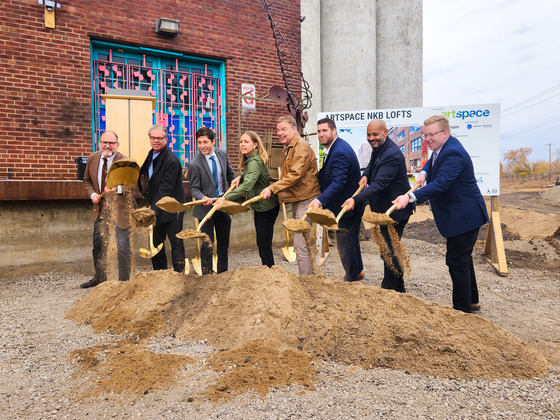 Kevin Reich, Executive Director of MWMO, joined Artspace Senior Vice President for Properties Greg Handberg, Mayor Jacob Frey, Artspace Vice President Becky Carlson St. Clair, Artspace President Kelley Lindquist, Dan Miller of Capital One National Association, 1st Ward Council Member Elliott Payne, and Hennepin County development team member Zack Avery to ceremonially break ground on the NKB Lofts project.
Artspace celebrated a groundbreaking at the historic Northrup King Campus in Northeast Minneapolis on October 24. This exciting development will add 84 housing units and 8,120 square feet of commercial space for creative enterprises, further enhancing the campus as a vibrant hub for artists and the community.
This redevelopment goes beyond housing—Supported by $750,000 in MWMO funding, this project will manage stormwater runoff from 11.6 acres of impervious surfaces, capturing and treating polluted water before it reaches the river. By incorporating sustainable features like permeable pavement, bioswales, and a “stormwater street,” the project will prevent more than 2,600 pounds of sediment and 13 pounds of phosphorus from entering the Mississippi River annually.
The campus will also feature more than four acres of native prairie plantings, providing critical habitat for pollinators and creating a much-needed green space for the community. This project exemplifies how creative, sustainable development can revitalize urban spaces while protecting our environment.
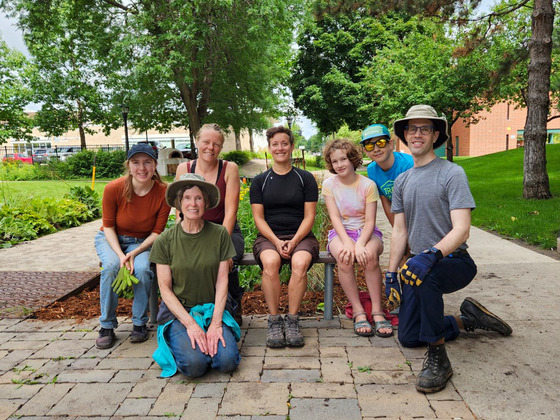 Minnesota Water Stewards Andi Hayes and Megan Reich showcased their revitalized raingardens at a community event last month at Holy Trinity Lutheran Church in south Minneapolis. The event celebrated the culmination of their capstone project—a centerpiece of the Minnesota Water Steward training program that empowers Stewards to hone their skills in water quality protection and community engagement.
Originally installed in 2010 with an MWMO Stewardship Fund grant, the raingardens at Holy Trinity had initially been well-cared for, but time revealed areas for improvement. Andi and Megan worked closely with church staff and volunteers to assess the function of the raingardens, pinpoint problem areas, and develop creative solutions. Their efforts included fixing erosion, finding strategies to keep inlets and outlets clear of debris, and enhancing the gardens with a wider diversity of native plants.
The duo brought the community together, engaging church volunteers and fellow Minnesota Water Stewards in much of the work on the raingardens. They also equipped the church with a detailed maintenance guide, oriented staff to the updates, and built a network of volunteers dedicated to the long-term maintenance of the gardens. Andi and Megan will stay engaged with volunteer-led maintenance days and will continue supporting Holy Trinity in keeping the raingardens functioning and beautiful for many years to come.
Congratulations to Andi and Megan on their successful capstone project, and thank you to the Holy Trinity community for their partnership!
This November, we recognize National American Indian Heritage Month by reflecting on the deep, enduring connections between Indigenous peoples and the lands and waters we steward. Indigenous knowledge and history provide valuable insights in shaping our understanding of the Mississippi River and its surrounding watershed.
Explore the new interactive walking trail at Owamni (St. Anthony Falls) in Minneapolis, created by Dakota-led nonprofit Owámniyomni. This initiative highlights Dakota stories and history along the Mississippi River, raising visibility and honoring cultural heritage. Learn more about the trail.
We also recommend a podcast from our neighboring watershed district: the Ȟaȟá Wakpádaŋ/Bassett Creek Oral History Project, which shares Indigenous stories from the suburban watershed, bringing new perspectives to the relationships between water, land, and community. Listen to the podcast on YouTube.
This month, we celebrate these efforts to amplify Indigenous voices and history, finding inspiration in their vital connections to the lands and waters we all work to protect.
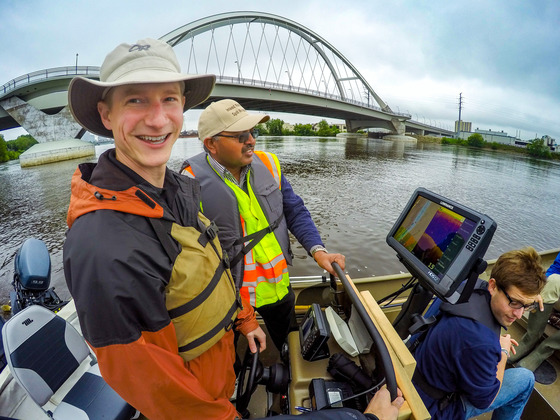 MWMO staff conducting bathymetric mapping in 2016.
Minnesota voters have spoken loud and clear: they care deeply about the environment. With an overwhelming 77% approval, voters renewed the Environment and Natural Resources Trust Fund (ENRTF) through 2050, securing over $100 million annually for conservation efforts across the state. Since 1991, the Minnesota Lottery has fueled critical projects that protect waterways and enhance wildlife habitats. The Mississippi Watershed Management Organization (MWMO) has used these funds to drive clean water initiatives, prevent pollution, and restore vital habitats along the Mississippi River.
Past funding has enabled MWMO to launch impactful projects, including:
-
Bathymetric Mapping of the Mississippi River: This project provided crucial data on the river's ecosystem and how it adapts to changes in water flow and lock-and-dam operations, helping to guide efforts to improve river health and biodiversity.
-
Winter Salt Pollution Reduction Training: Through this collaborative initiative, MWMO and the MPCA have trained over 5,700 salt applicators statewide, helping reduce thousands of tons of salt from entering waterways each year and protecting water quality and aquatic life.
This renewed funding will continue to support critical environmental work across the state, funding projects that protect water quality, enhance wildlife habitats, reduce pollution, and ensure a sustainable future for Minnesota's natural resources. Beyond being a financial investment, this renewal is a powerful testament to Minnesotans’ shared commitment to preserving clean water and resilient ecosystems for generations to come.
Network: A River Connected at MWMO
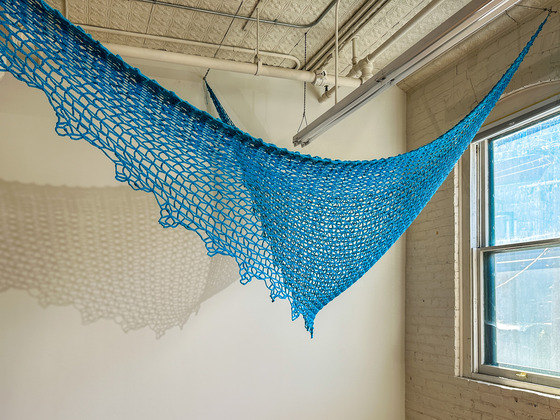 Victoria Bradford Styrbicki’s exhibit, Network: A River Connected, is on display at the MWMO’s Stormwater Park and Learning Center through January 10, 2024. Featuring hand-crafted fishing nets, photos, and video, the exhibit reflects a profound connection to the Mississippi River, with the fishing nets symbolizing interwoven community ties along the river’s length.
The artist will be available to host visitors and discuss her work on the following dates:
📅 December 16, 10 a.m.–3 p.m.
📅 January 6, 10 a.m.–3 p.m.
📍 Mississippi Watershed Management Organization
Visit during these times to meet the artist or stop by any time during regular exhibit hours—Monday through Thursday, 9 a.m.–3 p.m.—to tour the exhibit on your own. Just ring the doorbell for admission.
For more about Network: A River Connected, check out the Art Hounds episode from MPR, where Bradford Styrbicki’s work is featured alongside other local art.
Stewardship Fund Grants — December 13, 2024, by 4:30 p.m.
Photo of the Month
 MWMO monitoring staff, Mirae Guenther and Dustin McHenry, collect a soil sample at the Eighth Street Stormwater Planters project site.
MWMO monitoring staff are conducting five-year infiltration and soil testing 🌱 at the Eighth Street Stormwater Planters project site. By analyzing sediment particles and assessing system performance, the team ensures the planters continue to capture pollutants and protect water quality 🌊 in the Mississippi River watershed. Regular testing like this helps maintain long-term environmental benefits!
|